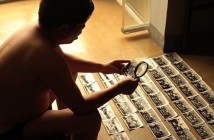
Though it shares an intimate and oft unseen view into the act of plastic surgery, Desire for Beauty’s scattered, passive, poetic nature works against its documentary tendencies, preventing the film from making a statement or leaving a resolute impression. Blending documentary and fiction, Gaudencio takes artistic liberties which make the film pleasant to watch but for the most part awkward and disharmonious. While the original score, filtered lighting, and expressive cinematography make for a unique documentary experience, these aspects simply do not befit the subject matter and instead come off as vain, insubstantial art fodder.
While the original score, filtered lighting, and expressive cinematography make for a unique documentary experience, these aspects simply do not befit the subject matter and instead come off as vain, insubstantial art fodder.
The film opens slowly, using music and visions of a beautiful landscape to prime the viewer for an unorthodox documentary. This is followed by an actress, Agata, explaining how she was asked to make a film that is not quite fiction, not quite documentary, but for which she would simply need to be herself and do what she loves—talk to people. Already the film acknowledges itself as a piece of fabrication, a documentary with intention. It does not hold the suspension of disbelief that a fictional film automatically does. So when the film next shows fictional scenes, re-enactments, and unnecessary but poetically shot details of the characters everyday lives, it rejects the directive set in its origin. These scenes refuse to aid the documentary drive, and thus remain at odds with the subject matter throughout the film.

That said, Desire for Beauty does in fact chronicle the lives of four individuals who undergo plastic surgery. It escapes the fictional poetic to truthfully convey what this experience is like and why people are willing to do it. Sometimes it uses direct address, wherein experts speak frankly on the subject of beauty. One explains that beauty makes life easier, another posits that beauty has only been desired since the mid-20th century. The experts give compelling information about beauty. The direct address is most communicative for a film which chooses often to communicate using poetic means, clouding its points rather than supporting them.
The rest of the film deals with the four subjects themselves. They speak with Agata and explain why they are interested in transforming themselves through plastic surgery. Kasia says she has always wanted larger breasts, ever since she would stuff her bra as a youth. Though with husband and child, she says she is doing this for herself. It is not a desire to get something out of it from others, but to feel confident from the inside. A gorgeous woman to begin with, it’s a little surprising that she would feel this need or that she, like most others, feel a sense of low self-esteem due to perceived body-image. In one of the most illustrative scenes of the film, Gaudencio takes us into the operating room as her silicon breasts are inserted. It later documents the pain she feels after the surgery, in a point to show what people are willing to go through in the name of beauty.
It offers a glimpse into the struggle for beauty but does not either condemn or congratulate it. In the end, this feature is to be admired, but for the most part it makes the film rather awkward and directionless.
Monika, Kuba, and Kamilla have different reasons for seeking plastic therapy. Monika expresses a fear of getting old, Kuba desires to enhance an acting career, and Kamilla believes it will help her deal with a painful past of being bullied for her large nose. Monika is denied surgery; she is currently too young for the fat fillings she desires. Apparently not everyone can immediately change their looks; one must first be accepted by a medical professional. Kuba receives botox treatment and undergoes the least stress and pain. Kamilla smiles greatly, happy to finally see herself with a lovely nose.
An epilogue allows us to see how surgery affects these four people down the road. Monika and Kasia find some happiness, the first without the surgery the second with it. Kuba remains unchanged, contending that botox for his lips was a good decision and that only the cheeks were unnecessary. Kamilla, on the other hand, expresses pain and dissatisfaction, not because she is unhappy with the surgery, but because the external change did not ultimately make her feel better about herself or her past. She remains with low self-esteem and offers to work harder on her self-worth.
With these varying results, Desire for Beauty, does not wish to offer a polemic or a call to arms as most documentaries do. The director chooses to remain detached rather than try to influence the viewer one way or another. For this reason, the film feels sincere. It allows the viewer to interpret the images and stories as they wish. It offers a glimpse into the struggle for beauty but does not either condemn or congratulate it. In the end, this feature is to be admired, but for the most part it makes the film rather awkward and directionless.
Though it shares an intimate and oft unseen view into the act of plastic surgery, Desire for Beauty’s scattered, passive, poetic nature works against its documentary tendencies, preventing the film from making a statement or leaving a resolute impression.



